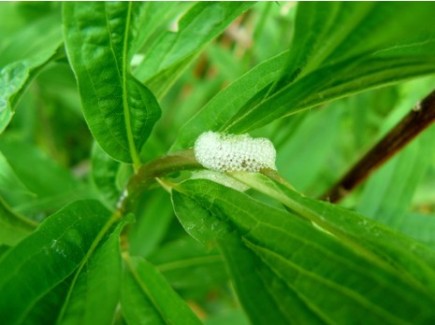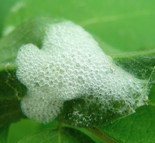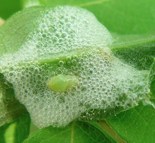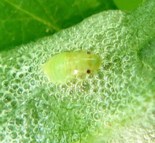
(The bubbly protection of the meadow spittlebug on a goldenrod stem)
Behold the meadow spittlebug (Philaenus spumarius), a homopteran in the family Cercopidae.
What’s that you say? You only see frothy bubbles? Well, my friend, deep within that sputum-y layer is a xylem-sucking fiend, tapping into the nutrient-poor system plants use to transport liquids for food. Technically, those bubbles aren’t spit because they’re not formed using the mouth but rather, erm, the other end. Dig down through the flatulent rear-end madness, and what you will find is a young “froghopper” in its nymph stage.



Why all the spittle?
Turns out it’s not all that complex. This spittl-y shield works like the “brilliant pebbles” of our vaunted Strategic Defense Initiative were supposed to work (some would say even better), keeping predators at bay through a layer of insulating tiny bubbles that hide the nymphs from a world full of hurt while they grow. Furthermore, these bubbles give the froghopperitos a moist shield to prevent dessication, something the SDI never managed to work into its plan (perhaps they could have partnered with that lotion obsessed guy from Silence of the Lambs?).
In any case, the spittlebugs seem to be having a good year this year, and I’m finding them in nearly every patch of goldenrod around. How ’bout you?
UPDATE: check out the comments for some good revisions from Vasha–looks like the anti-dessication angle might not be all it’s cracked up to be…






Very interesting, I have never heard of Cercopidae Sapsuckers before. Now I know.
In his book The Extended Organism: The Physiology of Animal-Built Structures*, J. Scott Turner has a section on the physiological function of the spittle nest. I will try to summarize it as best I can. Turner argues that (whatever the anti-predator function) the spittle nest can’t be for avoiding desiccation. It is formed from the excreted excess of the xylem, with lots of fibrous proteins added, which are metabolically expensive to make. These long-lasting proteinaceous bubbles actually lose water faster (10% faster, by Turner’s measurements) than unaltered sap flowing over the insect’s body would. Turner proposes (tentatively) that instead, frothing up the spittle is a way of excreting ammonia by diffusion. What little nutritive content xylem has is in the form of amino acids; froghoppers apparently don’t convert nitrogen waste to urea or uric acid like most terrestrial animals do, so they have to have some way of keeping toxic ammonia from building up. Turner writes, “Ammonia moves through a layer of bubbles about twice as fast as it does through a parcel of water with no bubbles. So it just may be that the spittle nest of spittlebugs serves as an accessory gas exchange organ.”
*Harvard U. Press, 2000; see also J S Turner (1994) Anomalous water loss rates from spittle nests of spittle bugs (Homoptera: Cercopidae). Comparative Biochemistry and Physiology 107A: 679-683.
Thanks for the info, Vasha–i’m a relative froghopper newbie, but I’m not sure that I completely agree with Turner’s dismissal of the anti-dessication hypothesis; they might not be as moisturizing as unaltered sap, but it seems like the real comparison to make should be whether the nymph dessicates more quickly with or without the bubbly layer; I am guessing that it would dry out faster without the bubbles (hence making the bubbles an anti-dessicant, of a sort). I’ll try and check out Turner’s full article, though, to see if he includes something that speaks to this. Thanks!
Wow – really interesting perspective from Vasha. I wonder if it comes down to the conclusion that most ecological investigations inevitably come to, i.e., it could be both. The cool part is Vasha’s reference to proteins that are metabolically expensive to make. If the spittlebugs are making these (not just siphoning them out of the plant) then it really suggests the proteins do something. What about predator deterrence (which is what I always thought the spittle was for in the first place)? Could be all three, I guess.
Well-timed post, sitta. In my recent blast across the country the spittlebugs were out in force pretty much everywhere. The only thing you should add is a picture of an adult froghopper – they’re really cool looking. http://images.google.com/imgres?imgurl=http://newsimg.bbc.co.uk/media/images/39343000/jpg/_39343007_frog_nature_h203.jpg&imgrefurl=http://news.bbc.co.uk/1/hi/sci/tech/3110719.stm&h=152&w=203&sz=13&hl=en&start=99&sig2=oCoxNQOTMnLZ3aPgSq9nRg&um=1&tbnid=_if5jIY61DtWqM:&tbnh=79&tbnw=105&ei=zuVmRumACYHkgAPVmoT_Dw&prev=/images%3Fq%3Dfroghopper%26start%3D80%26ndsp%3D20%26svnum%3D10%26um%3D1%26hl%3Den%26safe%3Doff%26client%3Dfirefox-a%26rls%3Dorg.mozilla:en-US:official%26sa%3DN
Vasha, are you an entomologist? It would be interesting to hear more about this question. Thanks for posting.
Aphriza,
Nope, I’m not an entomologist, just a dilettante; when I saw this post, something I’d previously read about spittlebugs came to mind, and I looked it up.
You’re right about it probably not being a good idea to try to pin down a single function for anything biological. J. Scott Turner argues that the froth can’t be intended to prevent dessication since, although it’s true that the nymphs dry up when removed from their plant, when they’re on it they’re constantly drinking a river of sap — they’ve no need to add proteins and froth it up just to stay wet. I find this a fairly convincing argument, but it could always do with more testing. However, in reference to predator deterrence he simply writes, “I can say from personal experience [the froth] doesn’t taste bad.” [!] How it tastes to him doesn’t necessarily tell us whether birds, parasitoids, and other enemies find it unpleasant. One thing has always puzzled me — these spittle nests tend to be very conspicuous. You’d think they’d be nothing but a signal to birds saying “juicy froghopper here”. So perhaps there is something deterrent about them, something that dissuades birds from seeking them out.
But certainly, it’s always a good guess that there may be multiple functions. That’s one of the main ways evolution works, after all.
The secretion is secreted from the Malpighian tubules of the nymphs of spittlebugs, when it is discharged from the anus, it mixs with air, then the foam is formed. While in the adult, the Malpighian tubules do not secret the above material, instead, the malpighian tubules responsible for discharging urine.